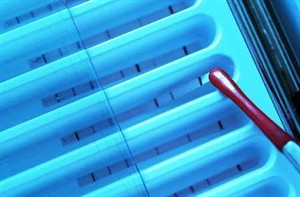Cochrane Review of RDT for diagnosis of drug resistant TB

While there are a number of different drugs available to people suffering from tuberculosis (TB), resistance to these drugs is a growing problem. People suffering from a drug-resistant strain of TB are more likely to die from the disease, and require treatment with what are described as “second-line” drugs. These drugs can cause more side effects and must be taken for longer.
A rapid and accurate test that could identify people with resistant TB, including a type of TB that is resistant to almost all anti-TB drugs, called XDR-TB, is likely to improve patient care and reduce the spread of drug-resistant TB.
GenoType® MTBDRsl is the only rapid test that detects resistance to second-line fluoroquinolone (FQ) drugs and second-line injectable drugs (SLID) as well as detecting XDR-TB. MTBDRsl can be performed on TB bacteria grown from sputum, which is called indirect testing and can take a long time, or can be performed immediately on sputum, which is called direct testing.
The authors reviewed the results from 21 studies, 14 of which reported the accuracy of MTBDRsl with direct testing, five of which looked at indirect testing and two of which looked at both.
By indirect testing, the test detected 83% of people with FQ resistance and rarely gave a positive result for people without resistance. In a population of 1000 people, where 170 have FQ resistance, MTBDRsl will correctly identify 141 people with FQ resistance and miss 29 people.
Of the 830 people who do not have FQ resistance, the test will correctly classify 811 people as not having FQ resistance and misclassify 19 people as having resistance. By direct testing, the test detected 85% of people with FQ resistance and rarely gave a positive result for people without resistance.
By indirect testing, the test detected 77% of people with SLID resistance and rarely gave a positive result for people without resistance. In a population of 1000 people, where 230 have SLID resistance, MTBDRsl will correctly identify 177 people with SLID resistance and miss 53 people.
Of the 770 people who do not have SLID resistance, the test will correctly classify 766 people as not having SLID resistance and misclassify four people as having resistance. By direct testing, the test detected 94% of people with SLID resistance and rarely gave a positive result for people without resistance.
By indirect testing, the test detected 71% of people with XDR-TB and rarely gave a positive result for people without XDR-TB. In a population of 1000 people, where 80 have XDR-TB, MTBDRsl will correctly identify 57 people with XDR-TB and miss 23 people. In this same population of 1000 people, where 920 do not have XDR-TB, the test will correctly classify 909 people as not having XDR-TB and misclassify 11 people as having XDR-TB. There was insufficient evidence recorded to determine the accuracy of MTBDRsl by direct testing for XDR-TB.
Dr Grant Theron from The University of Cape Town, lead author of the review said: “Our review shows that in adults with TB, a positive result for second-line drugs, either fluoroquinolone or injectable, or XDR-TB can be treated with confidence. However, given that a number of people tested negative while having a resistant strain, clinicians may still want to carry out conventional testing in some cases.”
Media Contact
All latest news from the category: Health and Medicine
This subject area encompasses research and studies in the field of human medicine.
Among the wide-ranging list of topics covered here are anesthesiology, anatomy, surgery, human genetics, hygiene and environmental medicine, internal medicine, neurology, pharmacology, physiology, urology and dental medicine.
Newest articles

Superradiant atoms could push the boundaries of how precisely time can be measured
Superradiant atoms can help us measure time more precisely than ever. In a new study, researchers from the University of Copenhagen present a new method for measuring the time interval,…

Ion thermoelectric conversion devices for near room temperature
The electrode sheet of the thermoelectric device consists of ionic hydrogel, which is sandwiched between the electrodes to form, and the Prussian blue on the electrode undergoes a redox reaction…

Zap Energy achieves 37-million-degree temperatures in a compact device
New publication reports record electron temperatures for a small-scale, sheared-flow-stabilized Z-pinch fusion device. In the nine decades since humans first produced fusion reactions, only a few fusion technologies have demonstrated…





















